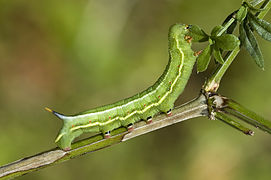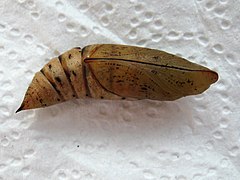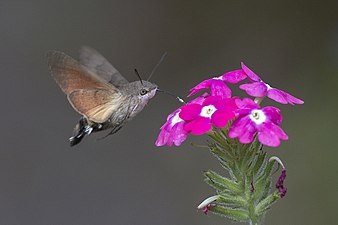| Hummingbird hawk-moth | |
|---|---|
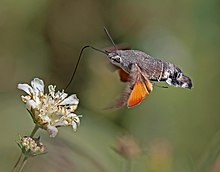
| |
| In flight | |

| |
| At rest | |
| Scientific classification | |
| Domain: | Eukaryota |
| Kingdom: | Animalia |
| Phylum: | Arthropoda |
| Class: | Insecta |
| Order: | Lepidoptera |
| Family: | Sphingidae |
| Genus: | Macroglossum |
| Species: | M. stellatarum
|
| Binomial name | |
| Macroglossum stellatarum | |
| Synonyms | |
| |

The hummingbird hawk-moth (Macroglossum stellatarum) is a species of hawk moth found across temperate regions of Eurasia. The species is named for its similarity to hummingbirds, as they feed on the nectar of tube-shaped flowers using their long proboscis while hovering in the air; this resemblance is an example of convergent evolution.
The hummingbird hawk-moth was first described by Carl Linnaeus in his 1758 10th edition of Systema Naturae. As of 2018, its entire genome and mitogenome have been sequenced.[1]
Distribution[edit]
The hummingbird hawk-moth is distributed throughout the northern Old World from Portugal to Japan, but it breeds mainly in warmer climates (southern Europe, North Africa, and points east). Three generations are produced in a year in Spain.[2]
It is a strong flier, dispersing widely in the summer.[3] However it rarely survives the winter in northern latitudes (e.g. north of the Alps in Europe, north of the Caucasus in Russia).
Moths in the genus Hemaris, also of the family Sphingidae, are known as "hummingbird moths" in the US, and "bee moths" in Europe.[citation needed][4] This sometimes causes confusion between this species and the North American genus.
Life cycle[edit]
Two or more broods are produced each year. The adult may be encountered at any time of the year, especially in the south of the range, where there may be three or four broods. It overwinters as an adult in a crevice among rocks, trees, and buildings.[5] On very warm days it may emerge to feed in mid-winter. Unlike other moths, they have no sexual dimorphism in the size of their antennal lobes.[6]
Ova[edit]
The glossy pale green ova (eggs) are spherical with a 1-millimetre (0.04 in) diameter. They are said to look like the flower buds of the host plant Galium, and that is where the female lays them. They hatch 6 to 8 days after laying.[5] Up to 200 eggs may be laid by one female, each on a separate plant.
Larvae[edit]
Newly hatched larvae are clear yellow, and in the second instar assume their green coloration. The larva is green with two grey stripes bordered in cream along the sides and with a horn at the rear end typical of sphingids. The horn is purplish red, changing to blue with an orange tip in the last instar.[5] They feed fully exposed on the top of the host plant and rest in among a tangle of stems. Although dependent on warmth and sun, the larval stage can be as rapid as 20 days.
-
Larva of Macroglossum stellatarum
-
Larva of same, Hampshire, UK, while on prepupational walkabout
Pupae[edit]
The pupae are pale brownish with a prominent, keeled proboscis, and two sharp spines at the end of the cremaster. They are enclosed in loose silken cocoons among the host plant debris or on the ground among leaf litter.[5]
-
Pupa (2 weeks old) of hummingbird hawk
Adults[edit]
The forewings are brown, with black wavy lines across them, while the hindwings are orange with a black edge. The abdomen is quite broad, with a fan-tail of setae at the end. The wingspan is 40–45 millimetres (1.6–1.8 in).
In the southern parts of its range, the hummingbird hawk-moth is highly active even when temperatures are high, and thoracic temperatures above 45 °C (113 °F) have been measured.[7] This is among the highest recorded for hawk-moths, and near the limit for insect muscle activity.
-
Closeup of its compound eye
-
The wing action is frozen in this photo by using electronic flash. This picture was shot in Hanko, Finland, latitude 60°N.
-
With proboscis extended, drinking nectar from a flower
-
Nectaring on Verbena
-
Slow motion video
Behaviour[edit]
Its long proboscis (25–28 mm (1.0–1.1 in))[8] and its hovering behavior, accompanied by an audible humming noise, make it look remarkably like a hummingbird while feeding on flowers. Like hummingbirds, it feeds on flowers which have tube-shaped corollae.[8] It should not be confused with the moths called hummingbird moths in North America, genus Hemaris, members of the same family and with similar appearance and behavior. The resemblance to hummingbirds is an example of convergent evolution. It flies during the day, especially in bright sunshine, but also at dusk,[7] dawn, and even in the rain, which is unusual for even diurnal hawkmoths.[5] M. stellatarum engages in free hovering flight, which allows more maneuverability and control than fixed-wing flight, despite high energetic cost.[9][6] Like many large insects, it relies upon Johnston's organs for body positioning information.[10]
Vision[edit]

The hummingbird hawkmoth's visual abilities have been studied extensively, and they have demonstrated a relatively good ability to learn colours.[11] They have a trichromatic visual system, and are most sensitive to wavelength in the range of 349-521 nm. They have been shown to discriminate a wavelength difference as small as 1–2 nm between sources. This discrimination is even more precise than Apis mellifera, or the western honey bee. Among other flower visitors, their visual system is similar to Papilio xuthus, or the Asian swallowtail butterfly, and Deilephila elpenor, the nocturnal elephant hawkmoth.[12][6] Their food preference is based mainly on visual identification, while D. elpenor preference relies upon olfactory identification.[6] Compared to D. elpenor, M. stellatarum have a much smaller number of ommatidia, but a larger optic lobe volume to provide more visual processing tissue.[6]
Habitat and host plants[edit]
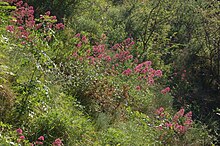
Hummingbird hawk-moths can be easily seen in gardens, parks, meadows, bushes, and woodland edge, where the preferred food plants grow (honeysuckle, red valerian and many others).[13]
Their larvae usually feed on bedstraws or madders (Rubia) but have been recorded on other Rubiaceae and Centranthus, Stellaria, and Epilobium.[5]
Adults are particularly fond of nectar-rich flowers with a long and narrow calyx, since they can then take advantage of their long proboscis and avoid competition from other insects.[5] Flowers with longer tubes typically present the feeding animal a higher nectar reward.[14] Proboscis length is thought to have been evolutionarily impacted by the length of flower feeding tubes.[14] Examples of such plants include Centranthus, Jasminum, Buddleia, Nicotiana, Primula, Viola, Syringa, Verbena, Echium, Phlox, and Stachys.[5] They are reported to trap-line, that is, to return to the same flower beds at about the same time each day.
In culture[edit]
Hummingbird hawk-moths have been seen as a lucky omen. In particular, a swarm of the moths was seen flying across the English Channel on D-Day, the day of the Normandy landings in the Second World War.[15] These moths, along with other moths, are in the family Sphingidae because their larvae were thought to resemble the Egyptian Sphinx.[16]
References[edit]
- ^ Li, Jun; Zhang, Yaoyao; Hu, Kunjie; Zhao, Yaqi; Lin, Ruirui; Li, Yan; Huang, Zhuoran; Zhang, Xu; Geng, Xuexia (2018-07-01). "Mitochondrial genome characteristics of two Sphingidae insects (Psilogramma increta and Macroglossum stellatarum) and implications for their phylogeny". International Journal of Biological Macromolecules. 113: 592–600. doi:10.1016/j.ijbiomac.2018.02.159. ISSN 0141-8130. PMID 29501752. S2CID 3983266.
- ^ Cuadrado, M. (2017). "The year-round phenology of Macroglossum stellatarum (Linnaeus, 1758) at a Mediterranean area of South of Spain (Lepidoptera: Sphingidae)". Revista de Lepidopterologia. 45 (180): 625–633.
- ^ Herrera, Carlos M. (1992-02-01). "Activity pattern and thermal biology of a day‐flying hawkmoth (Macroglossum stellatarum) under Mediterranean summer conditions". Ecological Entomology. 17 (1): 52–56. doi:10.1111/j.1365-2311.1992.tb01038.x. hdl:10261/44693. ISSN 1365-2311. S2CID 85320151.
- ^ P. Waring and M. Townsend. 2003, and later editions Field Guide to the Moths of Britain and Ireland
- ^ a b c d e f g h Pittaway, A. R. (1993). The Hawkmoths of the Western Palaearctic. London: Harley Books. ISBN 978-0-946589-21-0.
- ^ a b c d e Kelber, Almut; Warrant, Eric; Basil el Jundi; Charalabidis, Alice; Heinze, Stanley; Stöckl, Anna (2016-05-17). "Differential investment in visual and olfactory brain areas reflects behavioural choices in hawk moths". Scientific Reports. 6: 26041. Bibcode:2016NatSR...626041S. doi:10.1038/srep26041. ISSN 2045-2322. PMC 4869021. PMID 27185464.
- ^ a b Herrera, Carlos M. (1992). "Activity pattern and thermal biology of a day-flying hawkmoth (Macroglossum stellatarum) under Mediterranean summer conditions". Ecological Entomology. 17: 52–56. doi:10.1111/j.1365-2311.1992.tb01038.x. hdl:10261/44693. S2CID 85320151.
- ^ a b Faucheux, Michel J. (2013-03-01). "Sensillum types on the proboscis of the Lepidoptera: a review". Annales de la Société Entomologique de France. Nouvelle Série. 49 (1): 73–90. doi:10.1080/00379271.2013.767514. ISSN 0037-9271. S2CID 84400239.
- ^ Yao, J.; Yeo, K. S. (2019-05-30). "Free hovering of hummingbird hawkmoth and effects of wing mass and wing elevation". Computers & Fluids. 186: 99–127. doi:10.1016/j.compfluid.2019.04.007. ISSN 0045-7930. S2CID 145969157.
- ^ Kelber, Almut; Sane, Sanjay P.; Foster, James J.; Stöckl, Anna; Dahake, Ajinkya (2018-02-04). "Independent control of slow and fast flight manoeuvres in insects: the roles of vision and antennal mechanoreception". bioRxiv. 7: 222448. doi:10.1101/222448. PMC 6303104. PMID 30526849. Archived from the original on 2020-10-30. Retrieved 2019-05-30.
- ^ Kelber, Almut (1996). "Colour learning in the hawkmoth Macroglossum stellatarum" (PDF). Journal of Experimental Biology. 199 (5): 1127–1131. doi:10.1242/jeb.199.5.1127. PMID 9318956. Archived from the original on September 17, 2023. Retrieved October 21, 2011.
- ^ Rodríguez-Gironés, Miguel A.; Kelber, Almut; Telles, Francismeire J. (2016-02-15). "Wavelength discrimination in the hummingbird hawkmoth Macroglossum stellatarum". Journal of Experimental Biology. 219 (4): 553–560. doi:10.1242/jeb.130484. ISSN 0022-0949. PMID 26747900.
- ^ "Hummingbird Hawk Moth | Moth Migration". Archived from the original on 2022-05-20. Retrieved 2022-04-25.
- ^ a b Johnson, Steven D.; Moré, Marcela; Amorim, Felipe W.; Haber, William A.; Frankie, Gordon W.; Stanley, Dara A.; Cocucci, Andrea A.; Raguso, Robert A. (January 2017). Nicolson, Sue (ed.). "The long and the short of it: a global analysis of hawkmoth pollination niches and interaction networks". Functional Ecology. 31 (1): 101–115. Bibcode:2017FuEco..31..101J. doi:10.1111/1365-2435.12753. PMC 5363726. PMID 28344378.
- ^ "Hummingbird moths colonise UK". BBC. 10 June 2016. Archived from the original on 10 June 2016. Retrieved 10 June 2016.
- ^ "Featured Creature: Hummingbird Hawk-Moth". pbs.org. 11 August 2015. Archived from the original on 2019-06-12. Retrieved 2019-05-30.
Further reading[edit]
- Telles, Francismeire Jane; Lind, Olle; Henze, Miriam Judith (20 February 2014). "Out of the blue: the spectral sensitivity of hummingbird hawkmoths". Journal of Comparative Physiology A. 200 (6): 537–546. doi:10.1007/s00359-014-0888-0. PMID 24553915. S2CID 10608475.
- Farina, WM; Varjú, D; Zhou, Y (1994). "The regulation of distance to dummy flowers during hovering flight in the hawk moth Macroglossum stellatarum". Journal of Comparative Physiology A. 174 (2): 239–274. doi:10.1007/bf00193790. S2CID 39694791.
External links[edit]
- "69.010 BF1984 Hummingbird Hawk-moth Macroglossum stellatarum (Linnaeus, 1758)". UKMoths. Retrieved December 12, 2018.
- Moths and Butterflies of Europe and North Africa
- Pittaway, A. R. (2018). "Macroglossum Scopoli, 1777". Sphingidae of the Western Palaearctic. Retrieved December 12, 2018.
- Lepiforum e. V.
- Hummingbird Moth - Species info & Facts
